German tanks in World War II
Nazi Germany developed numerous tank designs used in World War II. In addition to domestic designs, Germany also used various captured and foreign-built tanks.[1]
.jpg)
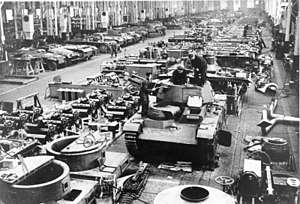
Development and uses
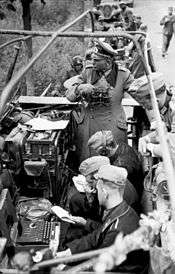
The indigenous German tank forces were a success due to tactical innovation more than tank quality.[2]
Using so-called "Blitzkrieg" ("lightning war") tactics, Guderian, Paul Ludwig Ewald von Kleist and other field commanders such as Erwin Rommel broke the hiatus of the Phoney War in a manner almost outside the comprehension of the Allied — and, indeed, the German — High Command. In actual tank-on-tank encounters the German armor performed poorly, but as a coherent unit, the combined arms tactic of the Blitzkrieg shocked the Allies.
The German Panzer forces at the start of World War II were not especially impressive. Only 4% of the defense budget was spent on armored fighting vehicle (AFV) production. Guderian had planned for two main tanks: the Panzer III and the Panzer IV, with production starting in 1937 and 1936 respectively. The design work for the Panzer IV had begun in 1935 and trials of prototypes were undertaken in 1937, but by the time of the invasion of Poland only a few hundred 'troop trial' models were available.[3] The development work was then halted and limited production was begun by Krupp in Magdeburg (Grusonwerk AG), Essen and Bochum in October 1939 with 20 vehicles built. However, even that low number could not be sustained, with production dropping to ten in April 1940. Such low production numbers were due to tanks being given a low priority for steel relative to the more conventional needs of an army, such as artillery shells.
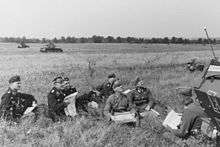
Nevertheless, the number of available Panzer IVs (211) was still larger than that of the Panzer III (98). There were also technical problems with the Panzer III: it was widely considered to be under-gunned with a 37 mm KwK L/45 and production of was split among four manufacturers (MAN, Daimler-Benz, Rheinmetall-Borsig, and Krupp) with little regard for each firm's expertise, and the rate of production was initially very low (40 in September 1939, 58 in June 1940) taking until December 1940 to reach 100 examples a month. The Panzer force for the early German victories was a mix of the Panzer I (machine-gun only), Panzer II (20mm gun) light tanks, and two models of Czech tanks (the Panzer 38(t) and the Panzer 35(t)). By May 1940 there were 349 Panzer III's available for the attacks on France and the Low Countries. Through superior command/control and tactics, the Germans were able to prevail in the Battle of France, despite the deficiencies of their Panzers.
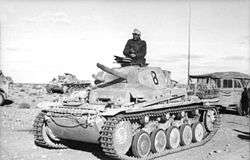
The objection of the limited gunnery of the Panzer III was recognized during its conception and its design was altered to include a large turret ring to make it possible to fit a 2250 ft/s (656 m/s) 50 mm KwK L/42 gun on later models. In July 1940, too late to see action in the final weeks of the Battle of France, the first 17 of these models were produced. Designated the Panzer III Ausf. F, the other changes included an upgraded Maybach engine and numerous minor changes to ease mass production.
The Ausf. F was quickly supplanted by the Ausf. G, which was the main tank of the Afrika Korps in 1940–41 and also saw action in Yugoslavia and Greece. Around 2,150 Panzer IIIs were produced, of which around 450 were the Ausf G. These tanks were still under-gunned, poorly armored and mechanically overly-complex in comparison to equivalent British tanks.[4] After fighting in Libya in late 1940 the Ausf. H was put into production with simpler mechanics, wider tracks and improved armor. In April 1941 there was a general 'recall' of the Panzer III to upgrade the main gun to the new 50 mm L/60, with the new Panzergranate 40 round, and muzzle velocity was pushed to 3875 ft/s (1,181 m/s). New tanks produced with this gun were designated Ausf. J.
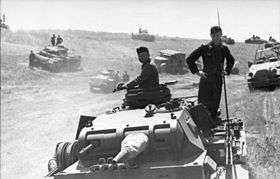
The invasion of the Soviet Union in Operation Barbarossa signalled an enormous change in German tank development. In July 1941 36 Panzer and motorized infantry divisions were assigned to the invasion fielding over 3000 AFV's. In June 1941, these tanks first encountered the Soviet T-34. The German tanks were outclassed in every aspect of battle performance. A little later the American-made M3 Lee and then M4 Sherman tanks were encountered in the Western Desert, the M4 outclassing German armor in that theater too.
As an immediate measure the Panzer III's armor was upgraded to 70 mm by additional plates and spaced armor was introduced to protect against hollow charge attacks. Nonetheless, the Panzer III was clearly outclassed and production was ended in August 1943 with the Ausf. M (a conversion of older types), the vehicle having been up-gunned to a 75 mm L/24 and downgraded to a support role. The Panzer III chassis did continue to be made until the end of the war as the base of a range of special purpose vehicles like Sturmgeschütz III.
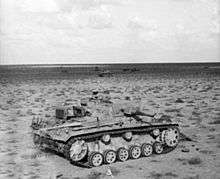
Slow production of the Panzer IV had been continuing, by the end of 1940 386 Ausf. Ds were in service and in 1941 a further 480 were produced, despite an order from the army for 2,200. The short 75 mm gun was the main advantage of the Panzer IV, weight and armor were close to that of the Panzer III. The Panzer IV became the most numerous tank of the Panzer divisions, although already outclassed in 1942 it was easy to maintain and simpler to produce than other German tanks. The Ausf. E was the major production variant, although the Ausf. F2 (later renamed Ausf. G) with a long high velocity gun was the more effective variant. First introduced in 1940 the 22 ton machine was progressively improved, with the addition of the L/43 gun the most significant change – it could penetrate 80 mm of armour at 1800 m. Later variants further improved the gun to a 75 mm L/48 but were mainly characterised by increasing the main armor and adding spacer and skirt armor to protect against anti-tank weapons. Zimmerit paste, to prevent magnetic charges attaching was also introduced on the Panzer IV. About 12,000 Panzer IV tanks (derived chassis included) were produced during the war, more than twice as many as the next German tank.
Despite continued efforts with the lighter tanks throughout the war the German designers did produce a direct counter to the heavier Allied tanks with the PzKpfw V, the Panther (in 1944 the PzKpfw designation was dropped and the vehicle was known simply as the Panther). Design work on the replacement for the Panzer IV had begun in 1937 and prototypes were being tested in 1941. The emergence of the T-34 led to an acceleration of this leisurely time-table. At the insistence of Guderian a team was dispatched to the eastern front in November 1941 to assess the T-34 and report. Three features of the Soviet tank were considered as most significant, top was the sloped armour all round which gave much improved shot deflection and also increased the armor thickness against penetration; second was the wide track and large road wheels that improved stability; and third was the long over-hanging gun, a feature German designers had avoided up to then. Daimler-Benz and MAN were tasked with designing and building a new 30–35 ton tank by next Spring. At the same time the existing prototype tanks were up-gunned to 88 mm and ordered into production as the PzKpfw VI, the Tiger.
The two T-34 influenced proposals were delivered in April 1942. The Daimler-Benz design was a 'homage' to the T-34, ditching the propensity for engineering excellence, and hence complexity, to produce a clean, simple design with plenty of potential. The MAN design were more conventional to German thinking and was the one accepted by the Waffenprüfamt 6 committee. A prototype was demanded by May and design detail work was assigned to Kniepkampf.
If the overhanging gun and sloping armor are ignored the Panther was a conventional German design: its internal layout for the five crew was standard and the mechanicals were complex. Weighing 43 tons it was powered by a 700 hp (522 kW) gasoline engine driving eight double-leaved bogie wheels on each side, control was through a seven-speed gearbox and hydraulic disc brakes. The armor was homogenous steel plate, welded but also interlocked for strength. Preproduction models had only 60 mm armor but this was soon increased to 80 mm on the production Ausf. D and later models had a maximum of 120 mm. The main gun was a 75 mm L/70 with 79 rounds, supported by one or two MG 34 machine guns.
The MAN design was officially accepted in September 1942 and put into immediate production with top priority, finished tanks were being produced just two months later and suffered from reliability problems as a result of this haste. With a production target of 600 vehicles a month the work had to be expanded out of MAN to include Daimler-Benz and in 1943 the firms of Maschinenfabrik Niedersachsen-Hannover and Henschel. Due to disruption monthly production never approached the target, peaking in 1944 with 330 a month and ending around February 1945 with at least 5964 built. The Panther first saw action around Kursk on July 5, 1943.
In addition to these mainstream efforts the German army also experimented with a variety of unusual prototypes and also put into production several peculiarities. Some Tiger tanks were fitted with anti-personnel grenade launchers that were loaded and fired from within the tank as an anti-ambush device.
Panzer
The word Panzer /ˈpænzər/ (German pronunciation: [ˈpantsɐ] (![]()
The word is used in English and some other languages as a loanword in the context of the German military. In particular, it is used in the proper names of military formations (Panzerdivision, 4th Panzer Army, etc.), and in the proper names of tanks, such as Panzer IV, etc.
The dated German term is Panzerkampfwagen, "tank" or "armoured combat vehicle". The modern commonly used synonym is Kampfpanzer, or Panzer. The first German tank, the A7V of 1918, was referred to as Sturmpanzerwagen (roughly, "armoured assault vehicle").
Overview per tank
Grosstraktor
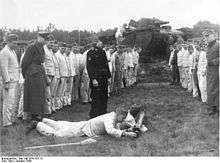
- Number built—6
Germany was forbidden to produce and use tanks because of the Treaty of Versailles. But a secret program under the code name "Traktor" was developing armored military vehicles and artillery. Grosstraktors were used only for training.
Leichttraktor
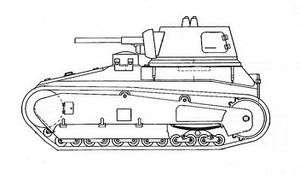
- Number built—4
Two years after the "Grosstraktor" project, prototypes of "Leichter Traktor" ("Light Tractor") were built. In the early years of World War II they were used as training tanks. The Germans tested the tank in the Soviet Union under the Treaty of Rapallo.
Panzer I
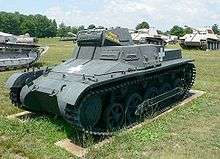
- Number built—1,493
The first of these German-built tanks was the Panzer I. It was not designed for combat, but rather as a training vehicle to familiarize tank crews with Germany's modern battle concepts, and to prepare the nation’s industry for the upcoming war effort. Nevertheless, the tank design did see actual combat, first during the Spanish Civil War of 1936, then again during World War II, and elsewhere.
Since the tank was never intended to be used in actual combat, it was plagued by weapon and armour shortcomings through its entire life. Attempts were made to improve the design, but with little success. The Panzer I’s participation in the Spanish Civil War did, however, provide vital information to the German military about modern tank warfare.
Panzer II
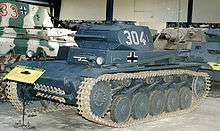
- Number built—1,856
The Panzer II was ordered into production because the construction of medium tanks, the Panzer III and IV, was falling behind schedule. The Panzer II was intended to “fill the gap” until the Panzer III and IV could come into full production. Along with the Panzer I, the II made up the bulk of German tank forces during the invasion of Poland and France.
Panzer III
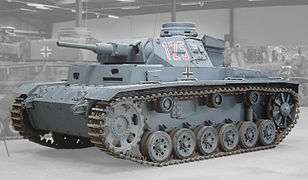
- Number built—5,764
The Panzer III was intended to be the main medium core of the German armored force when it was designed during the inter-war period. While it was originally designed to fight other tanks, its 37 mm and later 50 mm guns could not keep pace with Soviet T-34 and KV tanks, which, respectively, either had sloped armor or relatively thick armor, and both shared 76 mm guns. By 1941, the Panzer III was the most numerous of German tank designs. However, during the later parts of 1943, it was largely replaced by later versions of the Panzer IV and Panzer V "Panther". Its assault gun chassis variant, the Sturmgeschütz III, was, with just over 9,400 units built, the most widely produced German armored fighting vehicle of World War II.
Panzer IV
- Number built—8,800
The Panzer IV was the workhorse of the German tank force during World War II. It saw combat in all theaters, with the exception of the Pacific Theater, and was the only tank to remain in production for the entire war.
The Panzer IV was originally intended to be an infantry-support tank. It was thus armed with a 75 mm howitzer intended primarily to fire high-explosive shells in support of other tanks or infantry. By mid 1942, it was rearmed with a longer 75 mm dual-purpose gun that could defeat most Soviet tanks. In the latter half of the war, about half of all German tanks was a Panzer IV or a derivative.
Neubaufahrzeug
- Number built—5
The German Neubaufahrzeug series of tank prototypes were a first attempt to create a heavy tank for the Wehrmacht after Adolf Hitler came to power. Multi-turreted, heavy and slow, they were not considered successful enough to continue limited production. Therefore, only five were ever made. These were primarily used for propaganda purposes, though three took part in the Battle of Norway in 1940.
Panther
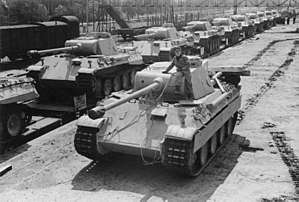
- Number built—6,000
The Panther was a medium tank (45 tonnes) with a crew of five, which was designed to counter the Soviet T-34 tank. In weight it was comparable to Soviet heavy tanks. This tank was introduced in the Battle of Kursk, one of the largest tank battles in history. It had sloped armor which increased the effective thickness of the armor from 80 mm (3.1 in) to roughly 140 mm (5.5 in), effectively making the front of the tank virtually impervious to enemy fire. However the sides of this tank were very vulnerable, ranging from only 40 mm (1.6 in) to 50 mm (2.0 in) of either barely sloped or completely flat armor plating. The tank carried a high-velocity 75 mm gun, which possessed more penetration than the Tiger's 88 mm gun at short range. Series production began in 1943. The tank was plagued with mechanical problems throughout its service life, several of which were never quite fixed, even after the war. Despite this, the tank is considered by some to have been the best tank in the war, and to have greatly influenced post-war tank designs, setting a role model for the balance of firepower, mobility, and armor protection.
Panther II
- Number built—1
The Panther II was built as a successor to the Panther tank, featuring improvements from lessons learnt from the Eastern front campaign. While visually similar, it was essentially a different tank, with thicker armor, a new turret, engine and gun. Many of the components from the original Panther were dropped and replaced by components from the Tiger and Tiger II. It would have been faster, though weighed more. One prototype was made but it was halted to focus on the Panther I. Some of the design influence went into the E-50.
Tiger I
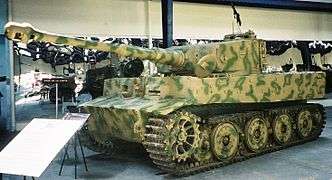
- Number built—1,347
In response to the T-34 after the invasion of the Soviet Union, the German forces ordered the construction of a new heavy tank. Designated as the Panzerkampfwagen VI, it was christened "Tiger" by Ferdinand Porsche. The tank had formidable firepower (the 88 mm anti-tank gun) and thick armor. It had some mechanical problems due to its weight. The Tiger had 100 mm of armor on the front of the hull and turret, while the sides had 80mm of armor. Armor was weakest on the rear of the turret. Americans and British tank forces first encountered the German Tiger I in North Africa, where it outclassed the British Churchills and American M4 Shermans.
Tiger (P)
- Number built—5
The VK45.01 (P), also known as the Tiger (P), was an unsuccessful heavy tank prototype produced by Porsche in Germany in 1942. It was not selected for production because it didn't work during testing in front of Hitler. So the Henschel-built VK45.01 (H) design to the same specification, using the same Krupp-designed turret as the Porsche prototype did, was produced as the Tiger I. Most of the 91 existing Porsche-produced chassis were instead rebuilt as self-propelled guns. The original main self-propelled gun made on the Tiger (P)'s chassis was the Ferdinand. This tank also had mechanical problems, partly from the complex, copper-dependent gasoline-electric drive system's poor grade of copper. It had a maximum of 200 mm of armor plating at the front.
Tiger II
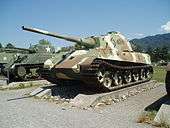
- Number built—492
Even larger and heavier than the Tiger I, the Pzkpfw VIB Tiger II. It is also known under the informal name Königstiger[6] (the German name for the "Bengal tiger"), often semi-literally translated as the King Tiger or Royal Tiger by Allied soldiers.[7] It was the largest tank mass-produced by German forces during the war, and remains among the heaviest mass-produced tanks ever. Its 8.8 cm KwK 43 could virtually knock out every Allied tank, while its sloped armor was thick enough to defeat most Allied guns (excluding hollow charge weapons). However, the Tiger II suffered from multiple mechanical problems due to its rushed development and excessive weight. It was named after the Tiger but it was a combination of innovations learned from the Panther and Tiger I.
Löwe
- Number built—0
Even larger and heavier was the Super-heavy tank Löwe. It translates to "Lion" in German. It remained on blueprints and was cancelled in favor of the heavier Maus.
Maus
- Number built—2, 1 was incomplete
The Maus was a super-heavy tank, heavier than the Löwe. It translates to "Mouse" in German. Only 2 prototypes were built, one of which was incomplete, and only one had the turret mounted, which was later destroyed. The other chassis was captured by the Soviets, who later mounted the turret from the other, completed Maus, which had its chassis destroyed at the end of the war by demolition charges.
E-100
- Number Built—1 incomplete
The Panzerkampfwagen E-100 (Gerät 383) (TG-01) was a German super-heavy tank design developed near the end of World War II. Only one chassis was produced with no turret made.
Panzer IX and Panzer X
The Panzer IX and X were 2 fictional super-heavy tank designs created for propaganda and counterintelligence purposes.
Ratte
- Number built—0
The Ratte was the heaviest tank design of World War II German tanks. Ratte translates to "Rat". It was cancelled before any work was started on it.
See also
- Neubaufahrzeug
- Entwicklung series
- German armoured fighting vehicles of World War II
- Military technology during World War II
- German armoured fighting vehicle production during World War II
- Panzerschreck
- Panzerfaust
- Panzerschiff
- Tank
- Tanks Break Through!
References
- Chamberlain, Peter (1969). Reviewed Work: German Tanks of World War II. American Library Association. p. 75.
- Beach, Jim (2007). British Intelligence And German Tanks, 1916-1918. History Reference Center. pp. 454–475.
- Harper, Douglas. "panzer". Online Etymology Dictionary.
- Jentz and Doyle 1993, p. 16.
- Buckley 2004, p. 119.
Bibliography
- Beach, Jim. "British Intelligence And German Tanks, 1916-1918." War In History 14.4 (2007): 454-475. History Reference Center. Web. 26 Oct. 2015.
- Buckley, John (2004). British Armour in the Normandy Campaign, 1944. London: F. Cass. ISBN 978-0-7146-5323-5.
- Cooling, B. F. "Review: British and American Tanks of World War II: The Complete Illustrated History of British, American and Commonwealth Tanks, Gun Motor Carriages and Special Purpose Vehicles, 1939-1945." Military Affairs 35.1 (1971): 34. JSTOR. Web. 26 Oct. 2015.
- Jentz, Thomas; Doyle, Hilary (1993). Kingtiger Heavy Tank, 1942-45. London: Osprey. ISBN 978-1-85532-282-0.
- Petre, Kellee Lyn. "Tanks: Ambitious Design For Victory." History Magazine 10.4 (2009): 13-16. History Reference Center. Web. 26 Oct. 2015.
- Stark, Warner. "Review: German Tanks of World War II: The Complete Illustrated History of German Armoured Fighting Vehicles 1926-1945."Military Affairs 34.4 (1970): 146. JSTOR. Web. 26 Oct. 2015.
External links
| Look up panzer in Wiktionary, the free dictionary. |